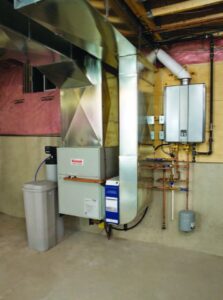A tankless water heater is a popular item these days and they offer real advantages — they save energy and space. That said, tankless heaters are not ideal for every home.
Sometimes a tank-style water heater makes more sense, as I’ll explain. But let me start with a few key concepts.
How a tankless water heater works
There are two kinds of water heaters: tank-style and tankless. Tank-style heaters keep 40, 50 or 60 gallons of water hot all the time in an insulated tank, slowly heating new water as it enters the tank to replace what’s been used.
Tankless heaters, as you’d expect, have no tank. Instead, they heat water only when someone turns on a water tap somewhere in the house. In this way tankless water heaters save energy by eliminating heat that would otherwise be lost from a tank full of hot water just sitting there.
This is why tankless water heaters are sometimes called “on demand” water heaters. They only heat water when it’s being demanded.
The whole idea of tankless water heaters makes sense, right? So why aren’t they ideal in every situation? There are a couple of reasons.
Electric vs. gas tankless heaters
At the moment, there are two kinds of tankless water heater systems on the market: electric and the more popular gas-fired (either propane or natural gas). Both electric and gas can work well, but the logistics of installation sometimes poses problems that aren’t always easy to see ahead of time.
For example, the big challenge faced by any tankless water heater is the short time available for delivering heat to the stream of cold water flowing through the unit.
To be useful in a typical household situation, a tankless heater must be able to raise the temperature of 20 litres of water (or about 5 gallons) by a whopping 40 degrees Celsius (100 F) in just one minute. That’s a huge rate of energy transfer and it’s the Achilles’ heel of electric tankless heaters. I’ll use my own house as an example.

As electricians have told me on several occasions, my 200-amp electrical service isn’t sufficiently large to handle the demands of a tankless electric heater along with all the other electrical loads connected to it.
But even if it had been, I’d still be cautious about installing an electric tankless heater because of probable changes in the way electricity will be metered in the future.
Then there’s the issue of how much hot water an electric tankless system can actually provide. For the various models I’ve investigated, water temperature would probably drop to lukewarm whenever more than a couple of hot water taps were turned on at the same time. Who wants that?
The huge, short-term energy demands of a tankless heater make gas a much more practical energy source for tankless water heating than electricity. Trouble is, not all of us have access to natural gas.
I don’t, and though I could’ve opted for a propane-fired tankless heater, that choice would have required the installation of an outdoor propane tank, supply lines and a vent through the basement wall.
I almost considered doing this, too, then I remembered how very easy it is to fix a tank-style water heater and how troubleshooting any kind of tankless system requires a specialized technician.
That did it for me.
I installed another tank-style heater when it came time to upgrade my old one. This tank-style heater also allows me to heat domestic hot water with my outdoor wood boiler for six months of the year — something that no tankless heater could do.
All this said, I’m convinced that tankless water heaters are a great idea in many situations.
They do use less energy and they certainly take up much less space than tank-style models. I just installed a tankless water heater in the small home my son built and it made a lot of sense.
The technology behind gas-fired systems is mature and efficient. Most units are about half the volume of a laundry basket and they operate quietly enough that they’re practical to install just about anywhere.
Just because my place isn’t one of them doesn’t mean yours isn’t.
Learn more about tankless water heaters in this video:
Question from a subscriber
In a follow-up question from a reader, I was asked:
Q: I’m building a home in the country involving a well. My plumbing contractor has told me they have not had good experience with tankless heaters in rural applications. He has recommended a tank. Would appreciate your comments.
A: The issue with tankless heaters is that the heat exchanger inside can build up mineral deposits from the water. If water hardness is more than 15 grains, you’ll need to back flush the heat exchanger using vinegar about once a year.
Valves are available to make it easy to shut off water to the heater, flush the exchanger, then re-open the water flow. It’s not a hard job (you’ll need a little pump and hoses to do it), but it is a chore.
Hard water is more of an issue with tankless heaters, though tank-style heaters do need to be flushed every year or two. The job is easier (no little pump is required), so that’s something to consider.
Another issue is access to propane. Are you planning to have propane on your property anyway? If not, then getting one for a tankless heater is another little hassle.

